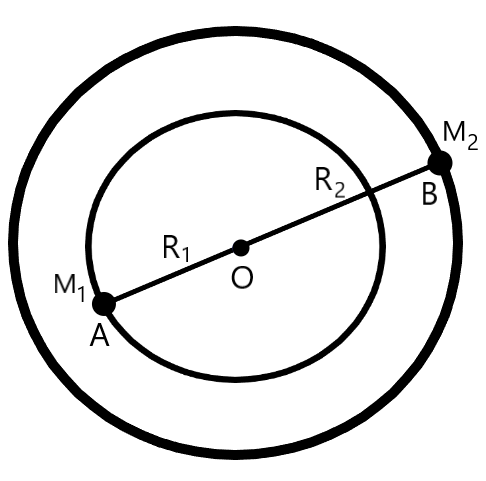Question
Question: A binary star system consists of two stars of masses \({{M}_{1}}\) and \({{M}_{2}}\) revolving in ci...
A binary star system consists of two stars of masses M1 and M2 revolving in circular orbits of radii R1 and R2 respectively. If their respective time periods are T1 and T2, then
A)T1>T2 if R1>R2
B)T1>T2 if M1>M2
C)T1=T2
D)T2T1=(R2R1)23
Solution
The point around which the stars in the binary star system revolve acts as the centre of mass of the system. By the property of the centre of mass, the product of mass and radius of one star in the binary star system is equal to the product of mass and radius of the other star. Also, gravitational force between the two stars in the binary star system is equal to the centripetal force acting on each star.
Formula used:
1)M1R1=M2R2
2)Fg=R2GM1M2
3)Fc=RMV2
4)Fg=Fc
Complete step by step answer:
We are provided with a binary star system, consisting of two stars of masses M1 and M2 revolving in circular orbits of radii R1 and R2 respectively. It is also given that their respective time periods of revolution are T1 and T2. Firstly, let us call the stars in the binary star system A and B, respectively, as shown in the figure.

The point around which both the stars in the binary star system revolve acts as the centre of mass of the system. Clearly, in the given figure, O acts as the centre of mass of both the stars A and B. From the definition of centre of mass of a binary system, we have
M1R1=M2R2
where
M1 is the mass of star A, as shown in the figure
R1 is the radius of the star A
M2 is the mass of star B, as shown in the figure
R2 is the radius of the star B
Let this be equation 1.
Now, force of gravitation between star A and star B is given by
Fg=R2GM1M2
where
Fg is the gravitational force between star A and star B
G is the gravitational constant
M1 is the mass of star A
M2 is the mass of star B
R=R1+R2 is the distance between star A and star B
Let this be equation 2.
Another force which acts on each star is centripetal force, which keeps each star revolving around O. If Fc1 represents the centripetal force acting on star A, then, Fc1 is given by
Fc1=R1M1V12
where
Fc1 is the centripetal force acting on star A
M1 is the mass of star A
R1 is the radius of the star A
V1 is the velocity of star A
Let this be equation 3.
Similarly, if Fc2 represents the centripetal force acting on star B, then, Fc2 is given by
Fc2=R2M2V22
where
Fc2 is the centripetal force acting on star B
M2 is the mass of star B
R2 is the radius of the star B
V2 is the velocity of star B
Let this be equation 4.
Now, for the binary system of stars to be stable, we know that all these forces acting on each star should be equal. Therefore, we can equate equation 2, equation 3 and equation 4, as follows:
